Springtime means rain, rain means puddles, puddles mean life. I thought I’d share some views of life in the water near my house.
There’s a ditch near my house that attracts frogs, particularly spring peepers and wood frogs. Last year the wood frog tadpoles amazed me with their iridescent underbellies, and how long they took to mature. This year, I’ve been marveling at the artistry of their little community.
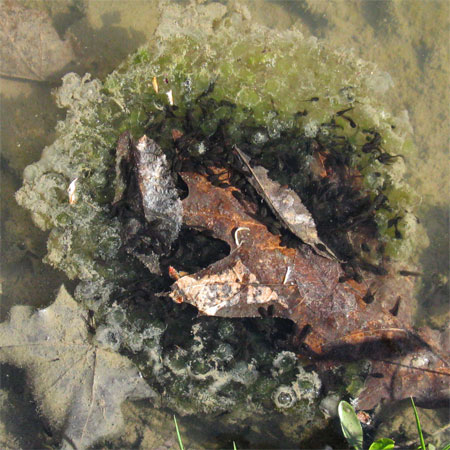 These tadpoles (actually I’m not sure if they’re peepers or wood frogs) burst out of their egg sacs, but for at least 4 days now, the majority of them have been hanging out in the center of the deteriorating sacs. I’m assuming that there are two reasons: (1) there’s safety in numbers, and (2) there’s food there. Do they eat those sacs? It looks to me like they do, but don’t assume that means its true. In any case, they make such an attractive, dense, dark spot of life in this muddy puddle, that I just have to stop and watch them on my walk.
These tadpoles (actually I’m not sure if they’re peepers or wood frogs) burst out of their egg sacs, but for at least 4 days now, the majority of them have been hanging out in the center of the deteriorating sacs. I’m assuming that there are two reasons: (1) there’s safety in numbers, and (2) there’s food there. Do they eat those sacs? It looks to me like they do, but don’t assume that means its true. In any case, they make such an attractive, dense, dark spot of life in this muddy puddle, that I just have to stop and watch them on my walk.
I tried to get a good shot of the unhatched eggs that are also in this puddle, since they’re decidedly different than the frog eggs that have hatched. Susan, Pfeiffer Nature Center’s Naturalist, has finally taught me to identify the difference between frog eggs & salamander eggs, and there’s no doubt in my mind that the remaining eggs are from salamanders, but I sure don’t know what type. In any case, the puddle is so muddy that the egg masses are completely covered with silt, and therefore didn’t photograph well. 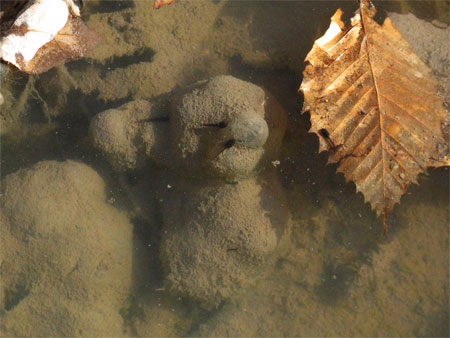 I considered trying to wipe one off, but thought I should leave nature to her own devices. You can make out some blobs here, with the frog tadpoles on top of the salamander egg masses.
I considered trying to wipe one off, but thought I should leave nature to her own devices. You can make out some blobs here, with the frog tadpoles on top of the salamander egg masses.
I moved from the ditch to my small pond. Â Also muddy, my pond is always writhing with mature spotted newts in the spring, who just can’t seem to get enough of laying eggs. Â I guess they know that a huge percentage of their babies make meals for the large mouth bass and bluegill in the pond, so have to hedge their bets pretty heavily.
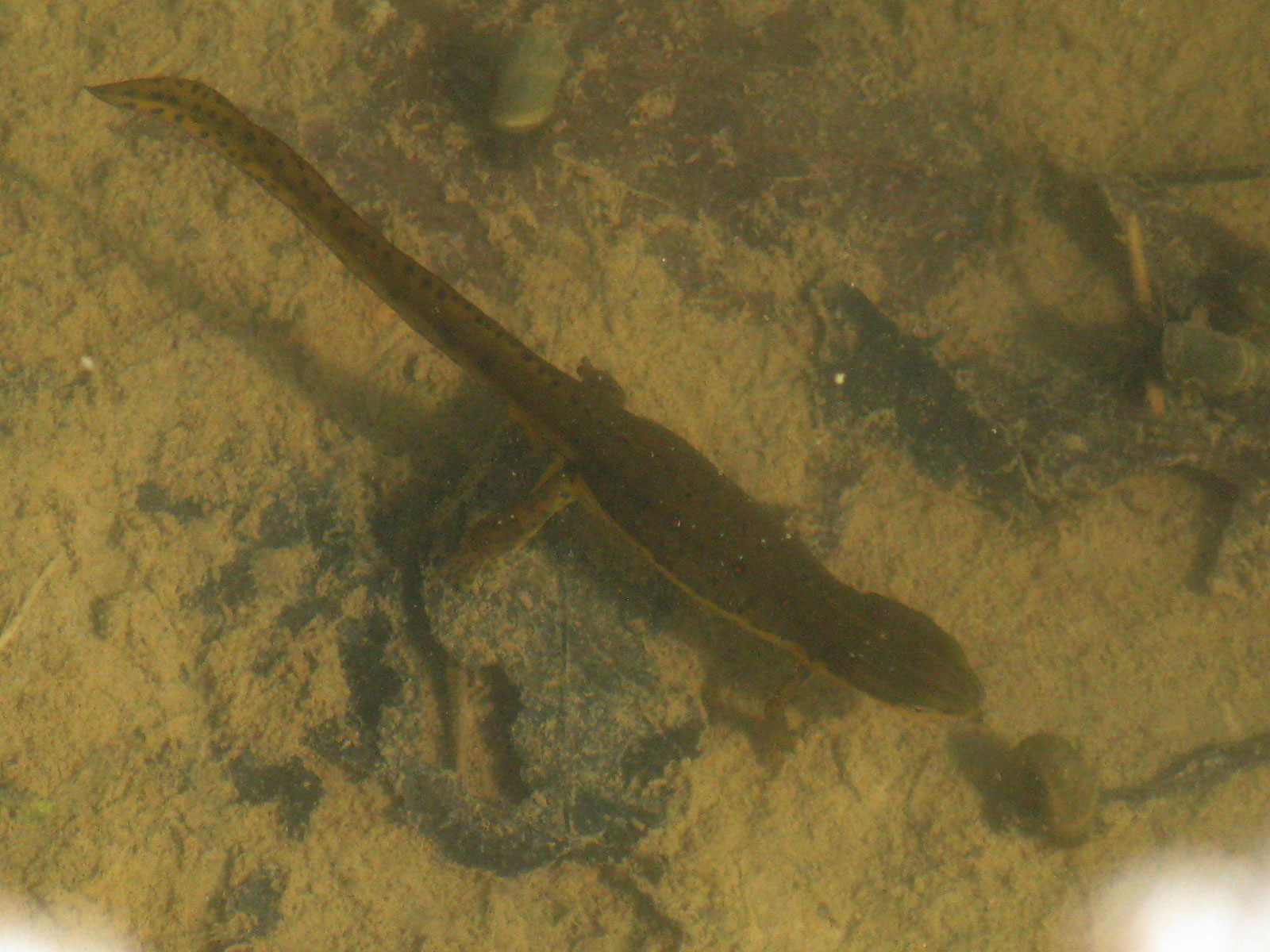
I really love the immature stage of these little guys, commonly called red efts. They’re bright orange with black-ringed spots down their backs. And they’re terrestrial little guys. It takes them 5 years to mature enough to darken their color and head back to the pond to mate. Ever since I was a kid I’ve loved picking them up, since they’re dry and feel really sweet in my hand. I learned just a few years ago that this is dangerous for the efts. Since they breathe through their skin, the oils from our hands can clog their pores and cause them real difficulties. So now I just bend down and watch them on the ground.
My pond is also growing quite a crop of snails this year. I don’t remember seeing them in prior years, at least not in these numbers. But maybe I just wasn’t paying attention. If you look closely, you can also see a snail by the nose of the salamander in the prior picture.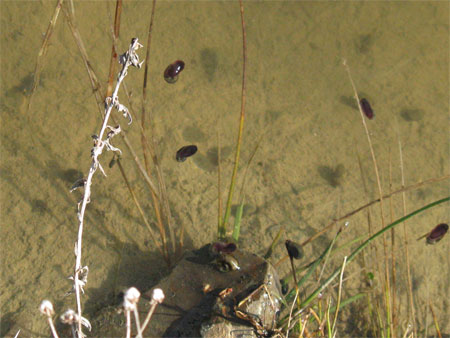
I must admit, far and away my favorite picture in this series of water sustaining life this one.
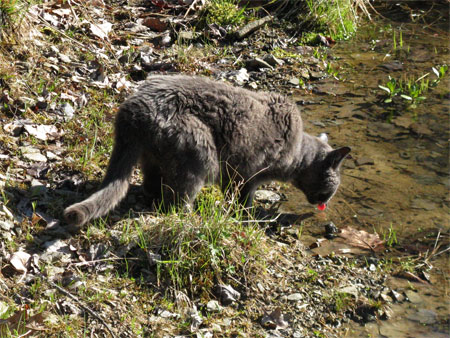 While I was trying to snap a decent fish photo, Magic wandered down to the pond for a drink. I just love the fact that I even managed to get his little pink tongue reaching out to toward the water.
While I was trying to snap a decent fish photo, Magic wandered down to the pond for a drink. I just love the fact that I even managed to get his little pink tongue reaching out to toward the water.
Your turn – what’s in the water near you?

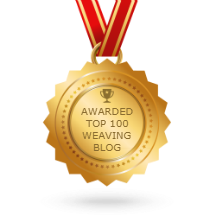
Dear Peg,
Love your nature photos. I too love to watch tadpoles and here the frogs singing at night under the stars. The smell of the earth after a rain is so sweet.I just love nature thanks to my Daddy.
Your jewellery is beautiful like all that you make. I really enjoy reading your blog.Thank you.
Sincerely
Marie
P.S.
I also have the wild columbine and have transplanted some into a friend’s garden in the city.
Thanks, Marie! I wish I had time to post more!